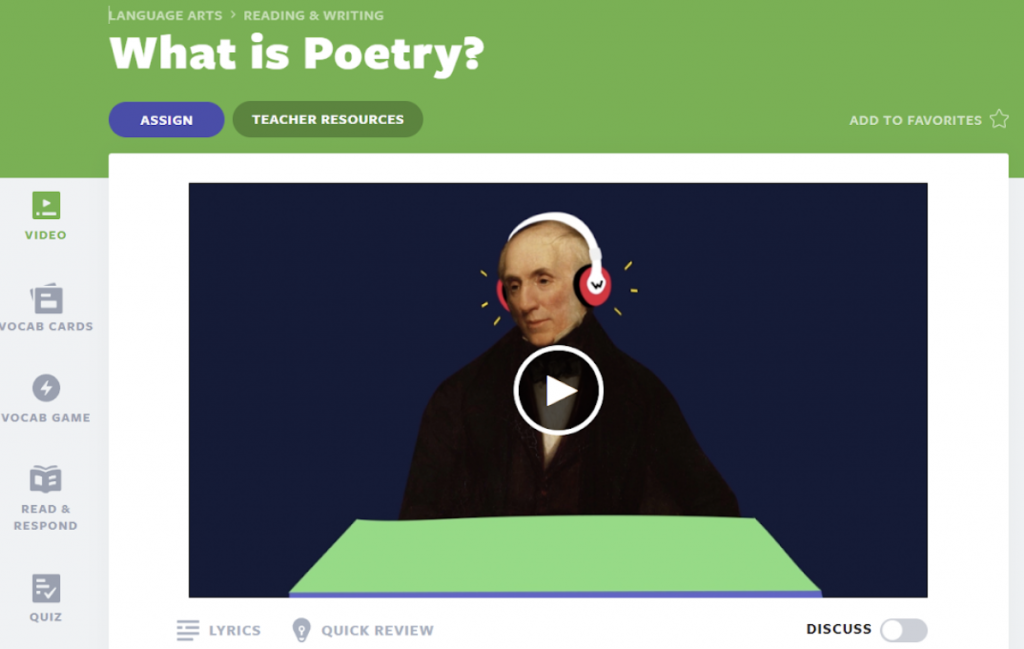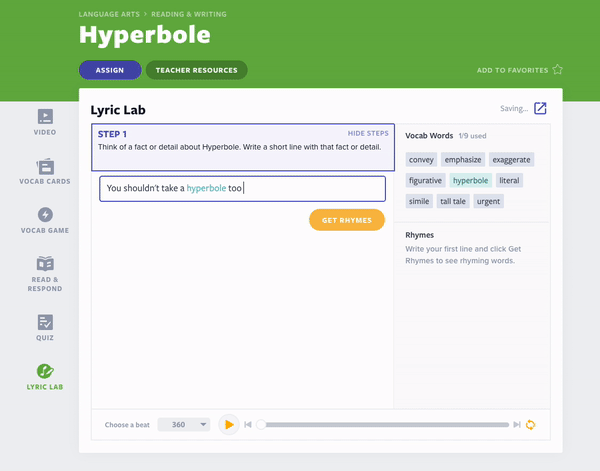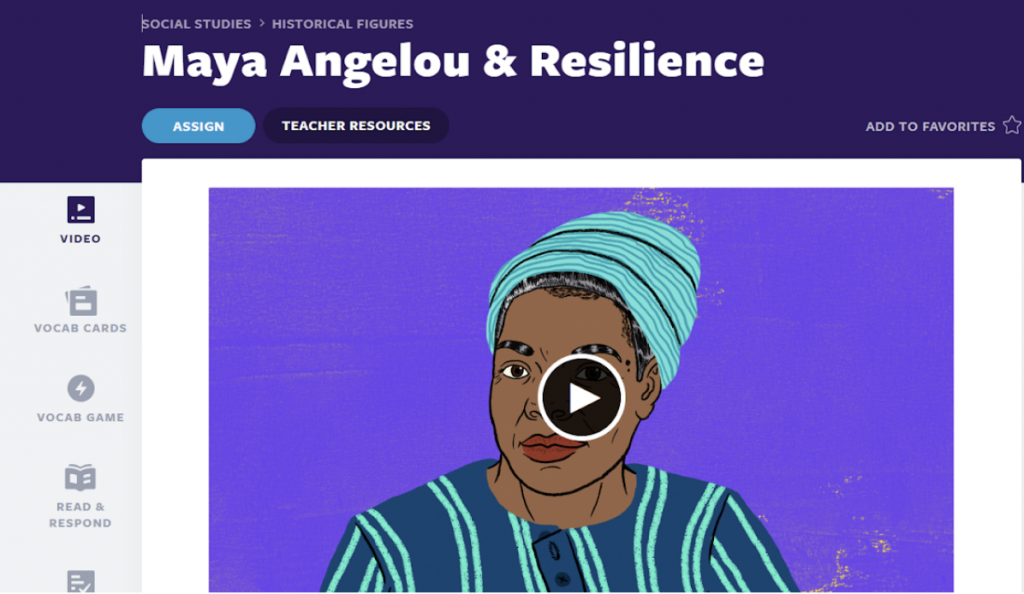
Poetry Month: 8 fun activities for teaching poetry in the classroom
Why is it important to teach poetry?
Poetry instruction is crucial for students because it enhances fluency, supports phonemic awareness, and elevates writing skills. Additionally, poetry fosters empathy, creativity, cultural understanding, and celebrates diverse voices. From epic Greek poems to the Harlem Renaissance, poetry offers insights into the thoughts and emotions of real people from various times and places, reflecting the world around us.
Poetry is a genre that’s a jack of all trades. Need to teach how fluency matters? Poetry helps readers practice tone, pitch, and volume. Want to help with phonemic awareness? Poems have rhyme, alliteration, syllable patterns, and assonance to aid young students just by listening. Wish to expand the writing of your students? Poetry pushes writers to elevate their style, asking for figurative language, expansive vocabulary, and imagery.
Flocabulary for poetry instruction
Flocabulary’s K-12 standard-aligned video-based lessons and activities leverage the power of hip-hop, storytelling, and emotional connections to cultivate literacy across the curriculum. Flocabulary is proven to strengthen a student’s understanding while highly engaging them, ultimately leading to improved student learning outcomes. Whether you’re teaching a poetry unit in your classroom or celebrating Poetry Month, these Flocabulary activities are the perfect addition to your lesson plans.
Captivate students and make learning experiences memorable and interesting through Flocabulary. Teachers can sign up below to access the activities and lessons shared in this blog post. Administrators can contact us below to learn more about the power of Flocabulary Plus.
Poetry Month activities for your classroom
1. Start off by teaching the basic concepts
When introducing poetry, it’s important to start off with the foundation. We often perceive poetry as lofty and complicated. However, Flocabulary’s video-based lessons make teaching poems relatable to students. Our videos are engaging and even mimic slam poetry. Not only that, we have videos to help new poets understand the craft and structure of poems.
Explore poetry activities perfect for teaching elementary, middle, and high school. Explore our library of poetic devices lessons which each include a video, handout, formative assessments, and activities:
- What is Poetry?
- Types of Poetry
- Rhyme & Rhythm
- Figurative Language
- Alliteration and Assonance
- Similes and Metaphors
- Hyperbole
- Descriptive Language
- Rhyme
2. Teach through famous poems
Teaching with famous poems offers students a unique opportunity to explore timeless works that have shaped literature and culture. By studying celebrated poets and their masterpieces, students delve into the intricacies of language, form, and meaning, while also gaining insight into historical and cultural contexts. This approach not only enhances students’ analytical skills and comprehension of poetry but also enriches their appreciation for the impact of the art form on human experience.
To take reading poetry to the next level, explore Flocabulary’s video lessons on adaptations of famous poems, such as the following for elementary and secondary. Assign these lessons to individual students for analyzing poetry or have them work in small groups to write a similar rhyme scheme.

Elementary poem lessons
- Wynken, Blynken, and Nod (Grade 2): In this adaptation of Eugene Field’s poem “Wynken, Blynken, and Nod,” students join an adventure at sea.
- The Jumblies (Grades 2-5): In Edward Lear’s 1874 nonsense poem, the Jumblies go to sea in a sieve.
- “Hope” Is the Thing with Feathers (Grades 4-5): In this adaptation of Emily Dickinson’s “‘Hope’ Is the Thing with Feathers,” a singer describes the strength of hope.

- I Wandered Lonely as a Cloud (Grades 4-5): In this adaptation of William Wordsworth’s “I Wandered Lonely as a Cloud,” students follow the speaker on a walk through nature and consider the value of experiencing nature.
- Afternoon on a Hill (Grades 4-5): In this adaptation of Edna St. Vincent Millay’s poem “Afternoon on a Hill,” the speaker revels in the beauty of nature.
- Subway Wind (Grades 4-5): In this adaptation of Claude McKay’s poem “Subway Wind,” the underground city air dreams of floating free in nature.
- Casey at the Bat (Grades 4-5): In this adaptation of Ernest Lawrence Thayer’s poem “Casey at the Bat,” a crowd watches a star baseball player come up to the plate.
Middle and high school poem lessons
- The Raven (Grades 6-8): In this adaptation of Edgar Allan Poe’s “The Raven,” the speaker encounters a mysterious visitor.
- Langston Hughes’s “Harlem” (Grades 6-12): This lesson introduces students to “Harlem,” the Langston Hughes poem that gave Lorraine Hansberry’s A Raisin in the Sun its name. Students will analyze the social context and figurative language that made the poem so powerful.
- Sonnet 18 (Grades 9-12): In this song, we put Shakespeare’s Sonnet 18 to music. The speaker questions whether it is possible to preserve the beauty of the young man through his own rhymes.


3. Leverage vocabulary’s role in poetry
Reading and writing poetry revolves around deliberate word selection, sparking vibrant discussions on vocabulary among readers worldwide. Studying figurative language helps students use words creatively to express complex ideas.
Flocabulary strategically uses hip-hop as the foundational medium to teach vocabulary and key concepts. Start discussions about poetry by learning the vocabulary used in the structure of poems with our Figurative Language lesson. Students watch the video to introduce the vocabulary and complete its supporting activities that deepen their understanding of the terms.
Watch the video below to see the power of Flocabulary videos!
4. Have students write poems using Lyric Lab
The Lyric Lab activity gives students the opportunity to create their own rhymes using the vocabulary covered in the accompanied Flocabulary lesson. You can assign a Lyric Lab for students to complete, or they can independently create their own rhymes simply by logging into their student account and selecting Lyric Lab for any lesson.
With Lyric Lab, students are developing the deepest level of understanding of vocabulary terms in a lesson. Students use the vocabulary terms that surfaced in a lesson to write about that topic. Hip-hop is a great mnemonic strategy to help students reflect and showcase their own personal understanding that they can use throughout the whole lesson unit.
Students can use these poetry month activities to write poems about any topic across the K-12 curriculum. Although Lyric Lab can be used to write a rap about a topic, students can also take those same lessons and tools to create poetry.
How to use Lyric Lab
Here’s how you can use Lyric Lab’s built-in rhyme generator to help students find rhymes as they write:
- Flocabulary’s video and Lyric Lab activity are perfect for an introductory lesson. Choose a poetry lesson from the library. Let’s use the Hyperbole lesson as an example.
- Students watch the lesson video, which includes engaging visuals and catchy rhymes about the poem or topics, individually or as a class.
- Students can then click on the Lyric Lab section of the Hyperbole lesson.
- Lyric Lab will list vocabulary words used in the video for students to use to create their own rhymes.
- As they type their rhymes, Lyric Lab will generate words they can use to rhyme in their next line.
- Once their lyrics are complete, students can select one of Flocabulary’s beats to accompany their song.
- Have students send a video or voice recording of their final song, have the class perform their masterpieces to each other, or simply use the written song as their poetry assignment!
After students create their own lyrics explaining what hyperbole is, it can guide them to write their own poems with hyperbole or even read poems where they have to find examples of hyperbole. Some great poetry examples to include in your activities are “I Wandered Lonely as a Cloud” by William Wordsworth and “The Raven” by Edgar Allan Poe.
5. Meet common core standards through public speaking
Speaking and listening standards appear across many grade levels, with students being asked to perform speeches orally and practice active listening skills. While writing poems can help support vocabulary acquisition and deep understanding, performing it will help teachers meet some speaking and listening standards as well.
Poetry’s short nature also helps students who are easily overwhelmed with lengthy writing assignments or those who are nervous about public speaking. When students share poetry aloud, they can experience figurative language and all its parts in new and interesting ways.

6. Host a poetry slam
Why not let students share their writing by hosting class slam poetry sessions? Poems are meant to be read aloud. It evokes feelings, which can be felt when spoken. Poetry slams are beneficial not only with writing but also with reading fluency.
Flocabulary’s videos teach concepts and represent what slam poetry sounds like. When students read a poem or poetry books, inspire them to try this approach.
Additionally, Lyric Lab can be tied to any lesson. It’s a helpful introduction to help students fully grasp poetry concepts, styles, and vocabulary.
7. Pick a poet and analyze their work
Pick a Poet is an activity among our list of Poetry Month activities that gives students the freedom to choose a poet to learn about and emulate his or her poetic style. Assign students a famous poet or style of poetry to mimic, or even better, let students choose what interests them.
Flocabulary has a library full of videos about poets, such as:
- Maya Angelou
- William Shakespeare, including the famous Sonnet 18
- Langston Hughes
- Sor Juana Inés de la Cruz
- James Baldwin
- August Wilson
Students can learn about the poet’s life, style, and impact on poetry, or simply learn about that particular poetic style. They then create their own poems and present information about that poet to the class.
8. Use the power of music
Music and poetry share a timeless relationship. In the past, poems were often sung, so why not teach using music? Create lessons in Nearpod with Flocabulary to demonstrate the close relationship between poems and music, adding digital poetry activities for students to complete along the way. Students pick lyrics from their favorite song or artist and analyze them through the lens of poetry. If students already studied different poetic styles, they can try to analyze what style of poetry that song would work in and why – evaluating rhythm, poetic devices, themes, etc.
Start using Flocabulary to teach poetry
Spring brings with it growth, and these poetry activities can be expanded and modified to fit in with any teacher’s lessons. April is the perfect month to teach the importance of poetry with enjoyable lessons that allow students creative freedom.
Captivate students and make learning experiences memorable and interesting through Flocabulary. Teachers can sign up below to access the activities and lessons shared in this blog post. Administrators can contact us below to learn more about the power of Flocabulary Plus.



